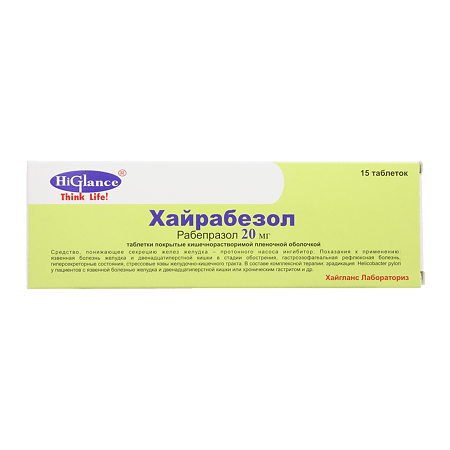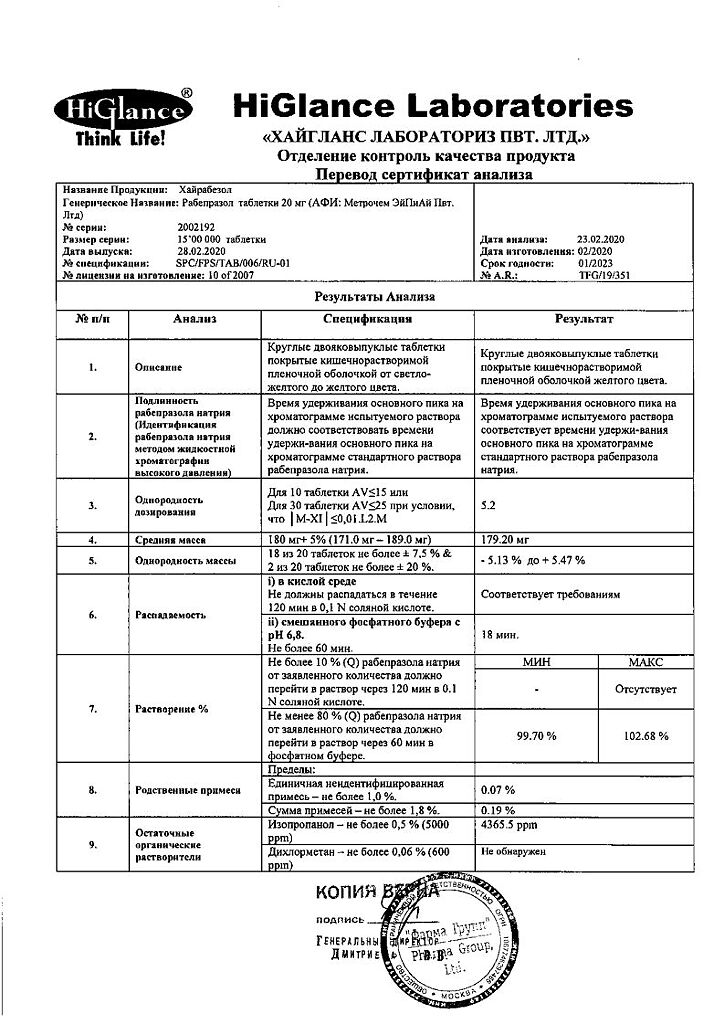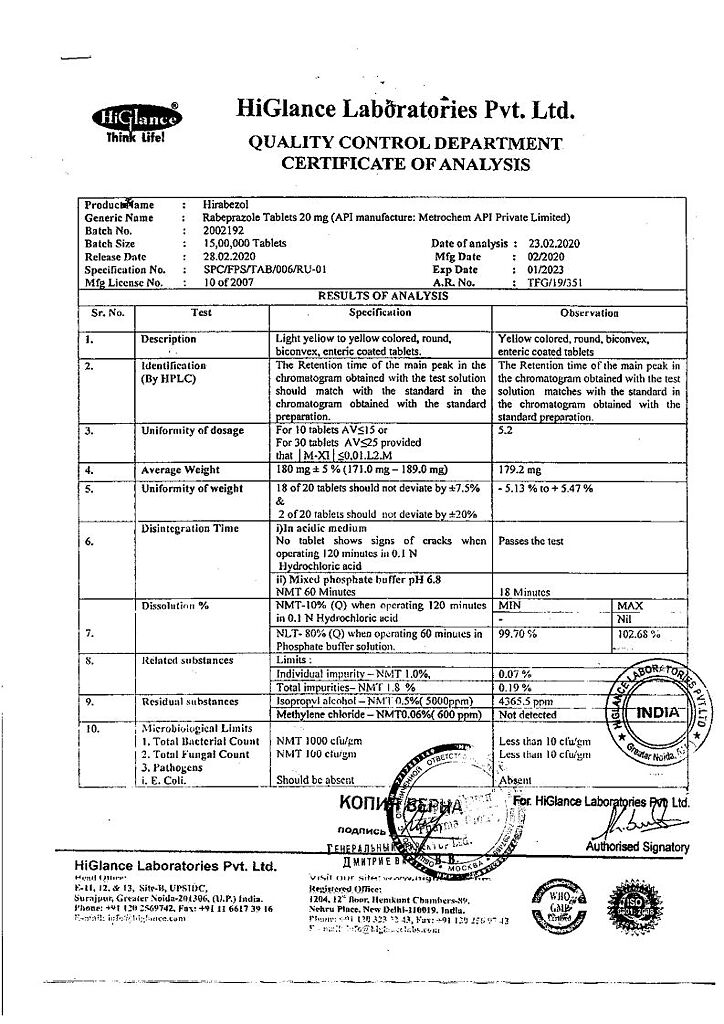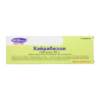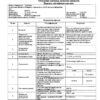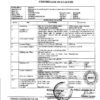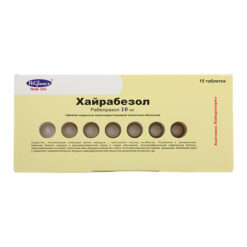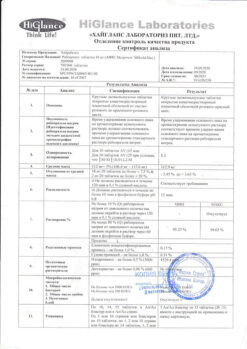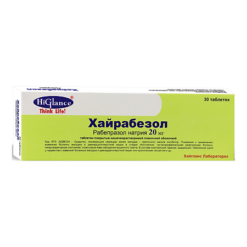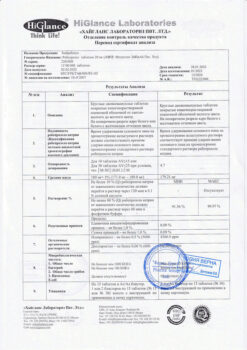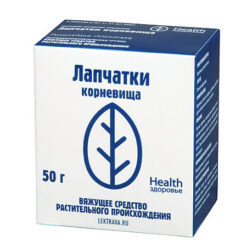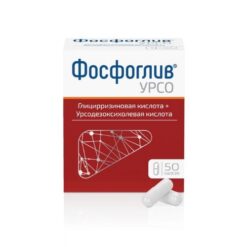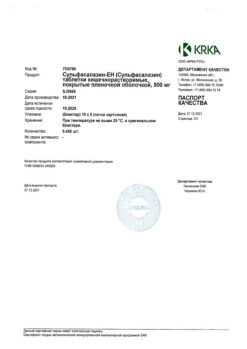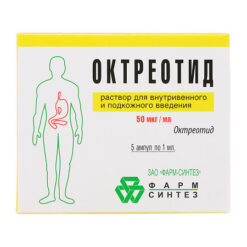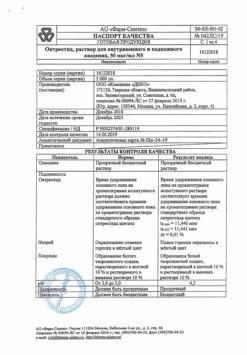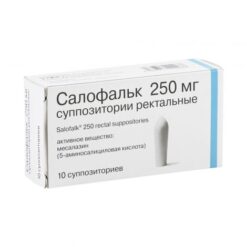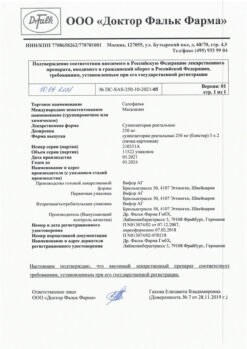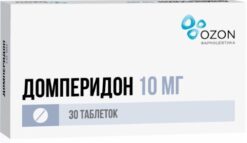Subtotal: €60.51
Hyrabezol, 20 mg 15 pcs
€17.93 €14.94
Hairabezol is an anti-ulcer.
Pharmacodynamics
. An antiulcer agent from the group of proton pump inhibitors (H+- K+- ATPase), it is metabolized in the parietal cells of the stomach to active sulfonamide derivatives, which inactivate the sulfhydryl groups of H+- K+- ATPase.
Blocks the final stage of hydrochloric acid secretion, reducing basal and stimulated secretion, regardless of the nature of the stimulus.
It has high lipophilicity, easily penetrates into the parietal cells of the stomach and concentrates in them with a cytoprotective effect.
The antisecretory effect after oral administration of 20 mg occurs within 1 hour and reaches its maximum after 2-4 hours; inhibition of basal and food-stimulated acid secretion after 23 hours after the first dose is 62 and 82%, respectively; duration of action is 48 hours. After the end of the intake, secretory activity normalizes within 2-3 days.
In the first 2-8 weeks of therapy, serum gastrin concentration increases and returns to baseline levels within 1-2 weeks after discontinuation of the drug. It does not affect CNS, SCS and respiratory system.
Pharmacokinetics
Absorption – occurs in the small intestine (due to the presence of acid-resistant enteric coating) – high, Tmax – 3.5 h. Values of Cmax and AUC are linear in the dose range from 10 to 40 mg. Metabolized in the liver with the participation of cytochrome P450 isoenzymes CYP2C19 and CYP3A4. Bioavailability is 52% and does not increase with multiple dosing. T1/2 – 0.7-1.5 h, clearance – (283±98) ml/min.
In patients with chronic hepatic insufficiency of mild or moderate degree AUC increases by 2 times, T1/2 – by 2-3 times after a single use. After administration of 20 mg of rabeprazole during 7 days AUC increased 1.5 times, T1/2 – 1.2 times.
In patients with stable terminal renal failure requiring hemodialysis (creatinine Cl less than 5 ml/min/1.73 m2), the distribution of rabeprazole sodium is close to that of healthy subjects.
In elderly patients, after taking rabeprazole for 7 days, the AUC is 2 times higher and the Cmax is 60% higher than in younger patients.
The binding to plasma proteins is 97%.
Extracted by the kidneys – 90% as two metabolites: mercapturic acid conjugate (M5) and carboxylic acid (M6); by the intestine – 10%.
In patients with delayed CYP2C19 metabolism after 7 days of taking rabeprazole at a dose of 20 mg/day AUC is increased 1.9-fold and T1/2 – 1.6-fold compared to the same parameters in fast metabolizers, while Cmax is increased by 40%.
Indications
Peptic ulcer of the stomach and duodenum in the acute stage;
gastroesophageal reflux disease;
hypersecretory conditions, including Zollinger-Ellison syndrome;
stress ulcers of the gastrointestinal tract.
As part of complex therapy:
eradication of Helicobacter pylori in patients with gastric and duodenal ulcers or chronic gastritis;
treatment and prevention of relapse of peptic ulcer associated with Helicobacter pylori.
Pharmacological effect
Khairabezol – antiulcer.
Pharmacodynamics
An antiulcer agent from the group of proton pump inhibitors (H + – K + – ATPase), is metabolized in the parietal cells of the stomach to active sulfonamide derivatives, which inactivate the sulfhydryl groups of H + – K + – ATPase.
Blocks the final stage of hydrochloric acid secretion, reducing basal and stimulated secretion, regardless of the nature of the stimulus.
It is highly lipophilic, easily penetrates into the parietal cells of the stomach and concentrates in them, exerting a cytoprotective effect.
The antisecretory effect after oral administration of 20 mg occurs within 1 hour and reaches a maximum after 2–4 hours; inhibition of basal and food-stimulated acid secretion 23 hours after taking the first dose is 62 and 82%, respectively; duration of action – 48 hours. After the end of administration, secretory activity normalizes within 2-3 days.
In the first 2–8 weeks of therapy, the concentration of gastrin in the blood serum increases and returns to initial levels within 1–2 weeks after discontinuation of the drug. Does not affect the central nervous system, cardiovascular system and respiratory system.
Pharmacokinetics
Absorption – occurs in the small intestine (due to the presence of an acid-resistant enteric coating) – high, Tmax – 3.5 hours. Cmax and AUC values are linear in the dose range from 10 to 40 mg. Metabolized in the liver with the participation of cytochrome P450 isoenzymes CYP2C19 and CYP3A4. Bioavailability – 52%, does not increase with repeated doses. T1/2 – 0.7–1.5 hours, clearance – (283±98) ml/min.
In patients with mild or moderate chronic liver failure, after a single dose, AUC increases by 2 times, T1/2 by 2-3 times. After taking 20 mg of rabeprazole for 7 days, AUC increases by 1.5 times, T1/2 by 1.2 times.
In patients with stable end-stage renal failure requiring hemodialysis (Cl creatinine less than 5 ml/min/1.73 m2), the distribution of rabeprazole sodium is close to that in healthy individuals.
In elderly patients, after taking rabeprazole for 7 days, AUC is 2 times greater, Cmax is 60% greater than in young patients.
Communication with plasma proteins – 97%.
Excreted by the kidneys – 90% in the form of two metabolites: a conjugate of mercapturic acid (M5) and carboxylic acid (M6); intestines – 10%.
In patients with slow metabolism of CYP2C19, after 7 days of taking rabeprazole at a dose of 20 mg/day, AUC increases by 1.9 times and T1/2 by 1.6 times compared with the same parameters in rapid metabolizers, while Cmax increases by 40%.
Special instructions
The patient’s response to rabeprazole therapy does not exclude the presence of malignant neoplasms in the stomach. Khairabezol tablets should not be chewed or crushed. The tablets should be swallowed whole. It has been established that neither time of day nor food intake affects the activity of rabeprazole.
In a special study in patients with mild or moderate hepatic impairment, the incidence of side effects of rabeprazole was not found to be significantly different from that in age- and sex-matched healthy individuals, but despite this, caution is recommended when first prescribing rabeprazole to patients with severe hepatic impairment.
In patients with impaired renal or hepatic function, no dosage adjustment of Khairabezol is required. The AUC of rabeprazole in patients with severe hepatic impairment is approximately 2 times higher than in healthy patients.
Hypomagnesemia. When treated with proton pump inhibitors for at least 3 months, cases of symptomatic or asymptomatic hypomagnesemia have been reported in rare cases. In most cases, these reports were received one year after therapy.
Serious adverse events included tetany, arrhythmia, and seizures. Most patients required treatment for hypomagnesemia, including magnesium replacement and discontinuation of proton pump inhibitor therapy. In patients who will be receiving long-term treatment or who are taking proton pump inhibitors with drugs such as digoxin or drugs that can cause hypomagnesemia (eg, diuretics), healthcare providers should monitor magnesium levels before starting treatment with proton pump inhibitors and during treatment.
Fractures. Observational studies suggest that treatment with proton pump inhibitors may increase the risk of osteoporosis-related fractures of the hip, wrist, and spine. The risk of fractures was increased in patients taking high doses of proton pump inhibitors for a year or more.
Active ingredient
Rabeprazole
Composition
1 tablet contains:
Active substance:
rabeprazole sodium 20 mg;
Excipients:
magnesium oxide;
mannitol;
corn starch;
povidone K30;
low-substituted hyprolose;
sodium stearyl fumarate;
Enteric coating:
cellacephate; titanium dioxide; red iron oxide dye.
Pregnancy
Rabeprazole should not be prescribed to pregnant women (there are no data on the safety of rabeprazole during pregnancy).
Breastfeeding should be stopped during treatment.
It is not known whether rabeprazole is excreted in breast milk.
Appropriate studies have not been conducted in lactating women.
Contraindications
Pregnancy;
breast-feeding;
children and adolescents up to 18 years of age;
hypersensitivity to rabeprazole, benzimidazoles or other components of the drug.
The drug should be prescribed with caution in cases of severe liver failure and severe renal failure.
Side Effects
Abdominal pain, nausea, loose stools or constipation
headache, dizziness
runny nose, cough
decrease in the number of leukocytes, blood platelets
allergic reactions.
Interaction
The drug Khairabezol does not interact with liquid antacids.
If drowsiness occurs, you should avoid driving and other activities that require increased concentration.
When taken together, the drug Khairabezol reduces the effect.
Overdose
Symptoms: There is minimal evidence of intentional or accidental overdose. There have been no cases of severe overdose of rabeprazole.
Treatment: A specific antidote for rabeprazole is unknown. Rabeprazole binds well to plasma proteins and is therefore poorly excreted during dialysis. In case of overdose, symptomatic and supportive treatment should be provided.
Storage conditions
In a dry place, protected from light, at a temperature of 8–25 °C
Shelf life
2 years
Manufacturer
Highglans Laboratories Pvt. Ltd, India
| Shelf life | 2 years |
|---|---|
| Conditions of storage | In a dry, light-protected place at 8-25 °C |
| Manufacturer | Hyglans Laboratories Pvt. Ltd, India |
| Medication form | enteric-soluble film-coated tablets |
| Brand | Hyglans Laboratories Pvt. Ltd |
Other forms…
Related products
Buy Hyrabezol, 20 mg 15 pcs with delivery to USA, UK, Europe and over 120 other countries.


